Diary of Spurs new pitch construction
Diary of a New Pitch Construction - Summer 2002

Prior to making a decision on the type of pitch for White hart Lane, I carried out a lot of research beforehand including visits to Liverpool and Reading. To me both of these pitches had stood out last season as good pitches.
I sat down with the manager in January and asked what he wanted from the pitch. I told him I could not keep grass at the south end of the stadium because of the light problems. Basically he wanted a pitch that was flat and stable. He likes to play a passing game.
I looked at everything on the market from palletised pitches to what we eventually went with - the fibre re-inforced system of Desso.
Fortunately budget wasn't an issue. I recommended what I felt was in the best interests of the club and in my interests with regard to providing a flat, stable surface. I had to bear in mind the south end which is as dark as anywhere in the country; it gets about 5/6 days of sunlight per year either side of 21st June. If it's cloudy that week, it doesn't get any!
Taking everything into account, it was clear to me that Desso was the way to go. Even if you lose grass cover, the surface remains stable. Desso pitches have been criticised for being hard, so getting the right balance of root zone was important. We were very specific about the sand. I saw the hardness assessment of the Liverpool pitch, and it was no harder than any of the natural sand or fibresand pitches.
The key is to get a surface you can manage and one that gives the manager what he wants. Some of the earlier fibresand pitches such as the one installed at Oldham were rock hard although I'd never seen a pitch drain so quickly. However, a pitch that cuts up and goes boggy is even more difficult to manage.
We incorporated 'Fytazone', which is a foam, into the root zone to try to retain some of the nutrients and to give some softness. Being honest I felt the pitch has probably been a bit too soft during the season to date.
I kept the grass at 28mm for the first 3 months of the season, and then down to 27mm because the assistant manager complained about it being too long! I did get an encouraging comment from one of the players in September who realised I was keeping the grass longer for the benefit of the pitch in the winter. The message appears to be getting through and some of them are appreciating what we're trying to do.
Obviously, we are continually monitoring the pitch during this first year. We've taken soil samples every 3 weeks during the season. Traction and hardness tests have also been done regularly. The double stitching on the touchline in front of west stand appears to have succeeded. It's showing no signs of being harder than any other area of the pitch and there is grass on that area in January for the first time anyone can remember.
We've spiked it once with a Wiedenmann, a 1.6m greens machine with 8mm needle tines to a depth of 100mm with no heave. Aeration is something we are planning for March this year and then spiking will become an ongoing operation to a depth of around 200 mm.
My initial thought was to put the Desso in after growing the grass, but I visited Croke Park in Dublin, their national Gaelic football stadium, and saw them installing the Desso before seeding. I was impressed with the results. Sometimes the machine can push the root zone forward and create ridges. Putting in the Desso first meant I could move the root zone and get the levels right before seeding.
I deliberately over seeded because I could not afford for it not to come through. We verticut the pitch where it came through too thick to thin out the sward. It's easier to remove grass, if you've got it there in the first place.
Overall the pitch has played well, although I do accept I have been lucky with the fixtures. Not too many match days with heavy rain, unlike the previous season when the pitch was a mess by January.
The pitch has suffered some damage from the blade boots that players are now wearing; they slice the turf, and I'm not sure whether they are any better, playing wise, than the normal studs. However, overall, I'm happy the way things have gone. I have included a works diary from the start of the reconstruction, to the first Premier game played. The construction was carried out by Hewitts Sportsturf.
I hope that it's a benefit to those of you planning major renovation or reconstruction this season. Below is the first section of my diary, I will be adding later months over the next few weeks.
Start date Monday 29th April 2002.
Day 1 - Windy, cloudy day with some odd showers.
Machinery arrived - It included : 3 Massey Ferguson tractors, 2 trailers, JCB 360 degrees, Daewoo 360 degrees, Massey Ferguson front loader, Blec laser grader, Rotaire (rotovator), Koro Field Topmaker, AFT Whizz Wheel, Cat DSM.
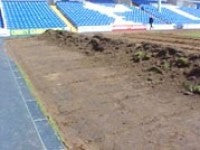
Day 2 - Heavy showers and strong winds all day.
We continued the rotovating and stockpiling, using JCB 360 degrees and tractor/trailer. Dug out along the edge of the North stand and also all the pop ups. 
Day 3 - Cloudy with odd sunny spell.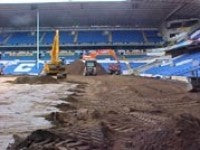
Continued rotovating and stockpiling with JCB 360 degrees. Dug out along West stand with Massey Ferguson front loader. Started removing root zone from the site with Daewoo 360 degrees and 20 tonne trucks. Dug out the irrigation boxes.
Day 4 - Cloudy with odd sunny spell; very heavy showers in afternoon.
Finished the rotovating, all grass now removed from the pitch.
Stockpiling and removing root zone from the site continues. Dug out East/ south edges with Massey Ferguson front loader. Started using the Koro from West stand, approximately 50mm deep on the first pass. Going gently because of undersoil heating pipes which
Day 5 - Cloudy with heavy showers in afternoon.
Stockpiling root zone and removing from site. Koro continues to strip root zone at approximately 50mm.
Days 6,7 and 8 - Cloudy with some sunny spells.
Continued with Koro and stockpiling.
Day 9 - Light rain, cloudy and sunny spells later.


I walked the pitch every day to make sure there were no stones or foreign bodies. We started whiz wheeling to create trenches either side of the 6 yard line for the new pipes to feed the set of riser sprinklers. It means we can water at half time should we need to.
Marked out and dug new holes for the pop up sprinklers around the edge of the pitch, and dug out a new drainage trench at the North stand end. I have decided to go with Hunter sprinklers based on what I saw at Bournemouth's ground. Previously I've used Rainbird and Toro's and been very satisfied. What I like about the Hunter, however, is the fact it is a sealed contained unit. With the others you can get a build up of sand in the sprinkler head. The sprinklers will be supplied and we will put them in ourselves. 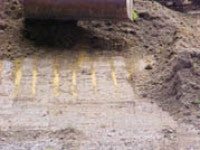
Day 10 - Cloudy then sunny spells.
Still removing root zone. Continued with the Whiz wheel to finish off the turf risers. Approved sand started to arrive; in total 3,000 tonnes of Leighton Buzzard DA 30 moist will be used. It's a medium to coarse sand which I've used before. Very good drainage 
Before we moved the sand on to the pitch we hand raked off the top of the gravel bands which contain the undersoil heating. These had become smeared with root zone during the excavation and I didn't want any barrier for future water to come across. The Cat DS and JCB 360 are used to move the sand onto the pitch.
Day 11 - Cloudy.

Day 12 - Cloudy with odd sunny spell.
Finally cleared the last of the soil. In total we took up 225 mm of root zone.
Began spreading sand by the west stand. Continued hand raking and exposing the gravel bands. Put in an extra drainage pipe and gravel along the north stand. Where we've had water logging problems in the past.
Day 13 - Cloudy start, sunny spells in the afternoon.
More sand delivered; 940 tonnes to date. Finished off hand raking the gravel bands. Laser graded south goalmouth and end of the
Day 14 - Much needed day of rest!
Day 15 - Overcast, rain for most of the day, some heavy showers.
Another 360 tonnes of sand delivered; spreading by east/west stands. Laser grading at west stand end. Put in new wiring for irrigation to the pump house.
Day 16 - Rain overnight. Cloudy with sunny spells and light shower.
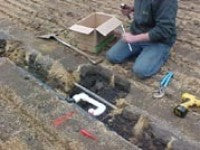
Day 17 - Sunny spells.
Another 100 tonnes of sand delivered. Needed more, so additional 160 tonnes ordered and delivered. Sand spreading continues. Put in remainder of pop-ups and valves along east/south stands. Wired up boxes and pop-ups, filled in with sand/gravel and ran tests. Laser grading the sand to prepared final levels.
Day 18 - Sunny and warm.
Still short so an extra 60 tonnes of sand ordered/delivered. Finished sand spreading and continued laser grading. Consolidated the edges where the pitch meets the track. Tested and positioned pop-ups; wired the control box. 80 tonnes of soil, containing the foam 'Fytazone', and 1 Desso machine delivered.
Day 19 - Sunny spells with heavy showers late on.
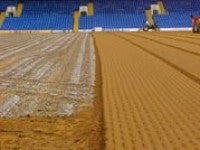
Day 20 -A lot of rain in the night. Sunny spells, showers in the evening.
Rain caused us some problems, but managed to finish mixing in the soil. Gave me the desired result - 95:5 sand to soil mix in the top 100mm on top of 125mm of pure sand. Fertilised with 1000kg of 0:24:24, this was mixed in with the soil and spread using a Vicon Vari-spreader. Levelled the surface with a stone burier. 
Day 21 - Rest day-Hoorah.!
Day 22 - Cloudy, sunny spells with heavy rain in evening.
Laser grading continues. Consolidated the edges. Now using the Tractor and lute and hand raking. Put in under-soil heating sensors (2.5m from south stand and 1.5m from east and west stands). Raised some pop-ups and boxes which had sunk on the outside of the 
Day 23 - Cloudy, sunny spells with heavy rain in evening.
Continued laser grading; need to get the levels spot on before putting Desso in. More consolidating of the edges. More tractor/lute and hand raking. Put in 6 centre pop-ups. Concreted in some new goal sockets by south stand. Started setting up the Desso machine.
Day 24 - Cloudy with sunny spells, windy.
Final laser grading. Finished hand raking the edges. Brushed the pitch with tractor and 8 inch brush. Began Desso sewing at west stand; double stitching in this area because it is one of the problem spots; heavy use by the substitutes warming up and the linesmen. Total number of runs to do the whole pitch is approximately 41, with each run taking approximately 8 hours.
Day 25 - Sunny spells and showers.
Desso continues with two machines. I ensured the areas were as flat as possible in front of the machines. Watering the pitch to keep sand moist and firm and general clean up of the surrounding areas.
Days 26 to 31
Desso sewing and watering. Had a night out at Walthamstow Dog Track, got very drunk with the lads from Desso, we all ended up sleeping in the St Johns Ambulance room for the night! Sorry no photos....
Day 32 - Sunny spells.
Continued Desso, we have now completed 30 runs. Had a problem with one of the Desso machines, it leaked hydraulic oil over the middle of the pitch, about an area of 4 sq metres. Proves the point doesn't it. Fortunately, taking the decision to put the Desso in before seeding has now worked in our favour because it was much easier to repair the area at that time rather than later in July with new grass on the pitch. By coincidence, West Ham had a similar occurrence, but they had seeded before putting in the Desso. They had to re-turf.